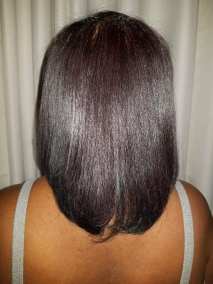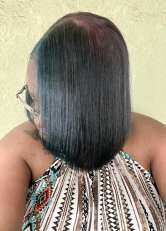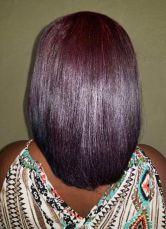Hello friends, it’s been a long time since my last post. All is well here. I was sick off and on between September and October of last year then I got really sick November 2022 to February of this year. It was bad!!! But I am back. Been working hard to stay healthy. The Pacific Northwest has had a really tough fall/winter season and so many people were sick right down to my grand children. I had never seen them so sick. But they are getting better. Let’s hope the warm weather keeps up.
So, today’s topic is about protecting your hair. I had visited a YouTuber I watch frequently, but had not done so in quite a while. Yesterday one of the videos I watched she touched on the subject of limiting the time you wear protective styles and this plays into the last few months when I was preparing for my hair appointment I had back on 04/22/23. I am pretty sure that I have also mentioned something along the lines of what she talked about, too, because it is very important that in wearing protective styles we are making sure that not only are we protecting our hair, but our scalp as well.
It starts with limiting the number of times you are manipulating your hair. Too much manipulation can cause your hair to break off and possibly other issues. You want to try tying up your hair or wrapping your hair where all you have to do is comb or brush it down and be good to go. In my case, and because I work at home, if I don’t have to leave the house I don’t let my hair down. It avoids me putting my hands in my hair unnecessarily.
Another thing I avoid is the over use of products because the scalps presents a natural oil on its own that is activated when I brush my scalp. Combined with other products, after a certain number of days it makes my hair stringy and look like I have a mass amount of oil in my hair. It’s not a good idea to continue flat ironing your hair when your hair becomes dirty.
Basically, when we are thinking about putting our hair into protective styles, we need to think about treating our hair. Using treatments that are specific to our hair types. And this does not mean just using protein treatments because there are other products out there are designed to protect your hair such as keeping it hydrated and conditioned. Take into consideration the type of protective hairstyle you are going to do. If you choose braids, you definitely want to treat your hair and your scalp and think about the length of time you plan on wearing the braids. The shaft will be put into a tight state, so he longer you keep your hair in braids, the weaker the shaft of your hair becomes. When you remove the braids, do it gently and with care to avoid your hair from breaking, meaning don’t just run a comb through your hair like a rake. Before going into the braided style, make sure your hair is detangled thoroughly. It makes the process of braiding your hair and taking your hair down an easy process. Keep your scalp oiled at all times to avoid unsightly dandruff.
Let’s talk about the two braid look. For example, I tend to put my hair into two braids for 1 – 2 weeks. I generally wash and condition my hair and use an oil and a leave in conditioner that are products designed for keeping my hair hydrated and is aimed at effective hair growth. I take my hair down once to add just a little oil and leave in conditioner. I brush it out lightly then I braid it back up. If I go over the two week mark, then I take it back down and wash and condition it again. This is my method of giving my hair a break from heat and constant manipulation.
 After I take the braids out of my hair, I minimized the amount of heat I was using because I would ordinarily use and limit the number of times I would comb my hair. This picture was taken 04/08/23. Approximately two weeks before my hair appointment. I braided up my hair shortly after I had taken this picture and did not take it down again until a week before and I washed and conditioned it in preparation for the relaxer and color touch up I was getting. Then I washed it again approximately 48 hours before the appointment so my hair and scalp would be somewhat clean.
After I take the braids out of my hair, I minimized the amount of heat I was using because I would ordinarily use and limit the number of times I would comb my hair. This picture was taken 04/08/23. Approximately two weeks before my hair appointment. I braided up my hair shortly after I had taken this picture and did not take it down again until a week before and I washed and conditioned it in preparation for the relaxer and color touch up I was getting. Then I washed it again approximately 48 hours before the appointment so my hair and scalp would be somewhat clean.
It’s also important to factor in regular trims to keep down the risk of split ends. Although there are products on the market that say they are formulated to repair split ends with the need of a trim, I find it very hard to believe that we can stop split ends once they start. How safe are these products? What ingredients do the contain? Do they work for all hair types? We have to remember that no one hair type is the same, maybe in some degree, but the care is different and unique in itself.

 Now, in these pictures, it is the day after I had my hair done at the salon. Which was nine weeks after my last relaxer and color touch up which I had done myself at home. At this visit I had a trim to clean up the ends and do some evening up, which turn out really well.
Now, in these pictures, it is the day after I had my hair done at the salon. Which was nine weeks after my last relaxer and color touch up which I had done myself at home. At this visit I had a trim to clean up the ends and do some evening up, which turn out really well.
Most likely at my next appointment I will ask my hairstylist to give me a thorough trim which means going throughout my entire hair to remove all of the frayed ends she finds to give my hair a cleaner finish and healthier look..
Lastly, when we look at hair weaves such as the lace front wigs, sew in weaves, glue in weaves, or other forms of weaving we have to look at the steps taken to protect the edges, the hair and the scalp, and the overall time frame the style is going to be worn. Generally, it is ideal to have the hair removed every two weeks to wash and condition your real hair, the hair that was removed be washed and conditioned, and your hair and scalp treated before the hair is replaced. If you do not take active measure to keep your hair and scalp clean, you can run into a matted mess that is very unhealthy and is harmful to your hair, and very difficult to manage.
You never want to leave a weave or wig in your hair for too long without care because of the potential damage you can cause your hair. Educating yourself on the best care for your hair and scalp when it comes to protective styles can be the best thing you can do.
If you are interested in learning more about your hair and its overall care, head on over to Cyn Doll’s YouTube channel, subscribe and click the bell to notified when she posts a new video. She does hair challenges, tells you about the best products you can use, explains the hair’s porosity, talks about hair types, shares valuable information about the health of the hair shaft, talks about her own hair care experience, and so much more. You’ll definitely learn so much and see hair care in a whole new perspective. I know I did when I started following her.
Feel free to tell anyone you feel would benefit from the post.
Thank you for reading.
